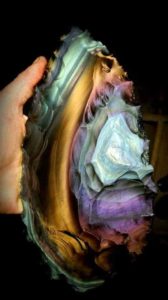
Obsidian
Obsidian is a volcanic glass that occurs naturally, formed as an extrusive igneous rock.
Obsidian is produced by rapidly cooling felsic lava extruded from a volcano with minimal growth in crystals. It is commonly found within the margins of rhyolitic lava flows known as obsidian flows, where the chemical composition (high silica content) gives rise to a high viscosity that forms a natural lava glass after rapid cooling. The inhibition by this highly viscous lava of atomic diffusion explains the lack of growth in crystals. Obsidian is hard, brittle, and amorphous, with very sharp edges fracturing. It was used in the past to produce cutting and piercing tools and was used as experimental scalpel blades for surgical purposes.
Colorful Obsidian : What Color is Obsidian?
Black is obsidian’s most common color. It can be brown, tan, or green, though. Obsidian may rarely be blue, red, orange, or yellow. Obsidian with multicolored iridescence caused by inclusions of magnetite nanoparticles “caused mainly by trace elements or inclusions”.
Pure obsidian usually appears to be dark, although the color may vary depending on the presence of impurities. Iron and other elements of transition can give a dark brown to black color to the obsidian. Most black obsidians contain magnetite, an iron oxide, nanoinclusions.
Very few obsidian samples are almost colorless. In some stones, a blotchy or snowflake pattern (snowflake obsidian) is produced by the inclusion of small, white, radially clustered mineral cristobalite spherulites in the black glass. Obsidian may contain patterns of the remaining gas bubbles from the lava flow, aligned with layers created as the molten rock flowed before cooling. These bubbles can have interesting effects like a golden shine (sheen obsidian). The inclusion of magnetite nanoparticles creating thin-film interference causes an iridescent, rainbow-like sheen (fire obsidian). Mexico’s colorful, striped obsidian (rainbow obsidian) contains oriented hedenbergite nanorods that cause thin-film interference to the rainbow stripping effects.
Where can obsidian be found?
Obsidian can be found in places where rhyolitic eruptions have occurred. It can be found in Argentina, Australia, Armenia, Azerbaijan, Canada, Chile, Georgia, Greece, El Salvador, Guatemala, Iceland, Italy, Japan, Kenya, Mexico, New Zealand, Papua New Guinea, Peru, Scotland, Turkey and the United States.
In the calderas of the Newberry Volcano and Medicine Lake Volcano in the Cascade Range of West North America and in Inyo Craters east of the Sierra Nevada in California, obsidian flows that can be hiked on are found. Yellowstone National Park has an obsidian mountainside between Mammoth Hot Springs and Norris Geyser Basin, and deposits can be found in many other western U.S. states including Arizona, Colorado, New Mexico, Texas, Utah, Washington, Oregon, and Idaho.
Obsidian can also be found in the eastern U.S. states of Virginia, as well as Pennsylvania and North Carolina.
In the central Mediterranean, there are only four major deposit areas: Lipari, Pantelleria, Palmarola and Monte Arci. Milos and Gyali were ancient sources in the Aegean.










